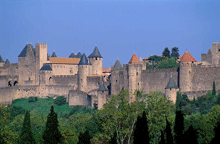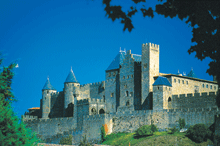The Languedoc-Roussillon: A realm of history
 From an aerial or bird’s eye view of the south-east part of France, the Languedoc-Rouissillon lies between the Rhone and the Pyr?n?es. It covers an area of 27,378 square kilometres with a population of over two million inhabitants. The Region has five ‘Departements’, Aude, Gard, H?rault, Loz?re and Pyr?n?es-Orientales. It is a place of contrasts where each department has kept its personality, contributing to the diversity and beauty of the Region. For many years it was a monoculture region of vineyards which have left their mark upon its inhabitants and landscape. It has almost 200 kilometres of Mediterranean coastline with sandy beaches well equipped for visitors that have helped the Languedoc-Roussillon to become the second largest tourist region of France. Its hinterland is characterised by mountain massifs of the Pyr?n?es and the C?vennes with landscapes of wild and natural beauty. Its walled cities, towns, villages, historical and cultural sites, are legendary. The Region plays host to many theatre and other important cultural events and boasts four major UNESCO World Heritage sites with universal patronage that help to protect its historical and cultural past.
From an aerial or bird’s eye view of the south-east part of France, the Languedoc-Rouissillon lies between the Rhone and the Pyr?n?es. It covers an area of 27,378 square kilometres with a population of over two million inhabitants. The Region has five ‘Departements’, Aude, Gard, H?rault, Loz?re and Pyr?n?es-Orientales. It is a place of contrasts where each department has kept its personality, contributing to the diversity and beauty of the Region. For many years it was a monoculture region of vineyards which have left their mark upon its inhabitants and landscape. It has almost 200 kilometres of Mediterranean coastline with sandy beaches well equipped for visitors that have helped the Languedoc-Roussillon to become the second largest tourist region of France. Its hinterland is characterised by mountain massifs of the Pyr?n?es and the C?vennes with landscapes of wild and natural beauty. Its walled cities, towns, villages, historical and cultural sites, are legendary. The Region plays host to many theatre and other important cultural events and boasts four major UNESCO World Heritage sites with universal patronage that help to protect its historical and cultural past.
The crusade against the Albigenses was undoubtedly the most dramatic episode in the history of Midi-Languedoc. To eradicate the Cathare heresy implanted in the south of France, Pope Innocent III gathered together with an army of crusaders which in l209 swept down upon the lands of the Count of Toulouse and the Viscount of Carcassone. After fierce battles, the Treaty of Meaux (or Paris) was signed in l229. It ratified the submission of the Count of Toulouse providing for the repression of the Cathare heresy and annexation of Languedoc by the French Kingdom. Roussillon which was formerly the Kingdom of Majorca became part of France after the Pyr?n?es treaty, signed with Spain in l659.
Territory of Gaul and Roman colonisation
In antiquity there was Greek settlement in the Region and much evidence is still present. More than 2,000 years ago the Roman Republic was fighting for survival. A priority was to definitively consolidate Roman possessions in Spain. In 118 BC proconsul Domitius Ahenobarbus crossed the Rhone with his legions. He had to establish a weather resistant inland communication link, and set up garrisons to protect it. He founded a home for the colony in Narbonne that became the first Roman city in Gaul. He also built the ‘military’ road that was to bear his name, the Via Domitia. It rapidly became a communications and trade route. The Via Domitia was part of a vast public road network l00,000 kms in length built by the Romans over eight centuries covering seven Mediterranean countries, France, Spain, Italy, Greece, Portugal, Tunisia and Algeria. They have been gathered together for appreciation of this exceptional common heritage as part of the European programme Interreg IIIB MEDOCC that maps the Roman routes and their different denominations.
The first Roman construction on the territory of the Gauls enabled Rome to organise the whole of southern Gaul, giving farmland to Roman colonisers and building new towns. As well as communication between Rome and its colonial cities, exchanges occurred between adjoining towns all along the route that were to stimulate the local economy. The Via Domitia, the oldest Roman road in Gaul, is an amazing construction that has left its mark on the landscape and crosses the Region from one side to the other, roughly twenty kilometres inland from the coast. Despite being abandoned for centuries, and though many a contemporary road hides the original materials in many places, entire portions of ballast and certain engineering feats are still visible. Numerous other vestiges of the Roman colonisation remain in place today.
The wine growing area of Languedoc-Roussillon dates back to prehistoric times and is one of the oldest and largest in the world. The vines cultivated by the Greeks, and developed by the Romans, stretch out across from the right bank of the Rhone to the Pyr?n?es and reach down as far as the Mediterranean coast. The Region experienced a period of great expansion during the Middle Ages enabling a whole variety of landscape to be developed due to commerce with the Mediterranean countries. With menhirs, dolmens, oppida and Roman monuments, Romanesque churches and chapels, cathedrals, castles, fortified villages and cities, the architectural and cultural heritage of the Languedoc-Roussillon is exceptionally varied and rich.
The Cathare religion and the Crusades
Catharism (from the Greek “catharos”, meaning pure) was a religion that spread rapidly in the early eleventh century over all of Western Europe and represented a real danger to the Roman Catholic Church. The religion was affiliated to the dualistic doctrines which had developed since Antiquity and similarly advocated the two fundamental principles of Good and Evil. These principles were inherited from other religions which developed in parallel to Christianity. Advocating total detachment from material possessions viewed as the emanation of Evil, the Cathares considered themselves as Christians but rejected the Old Testament. They believed in the re-incarnation which brought man progressively to perfection and eternal life. They were vegetarian and were obliged to abstain from carnal pleasures in total indifference to material assets. Only one sacrament was recognised: the consolamentum, through which one became a “Bon Homme” (or priest) and which was granted to the believer on his deathbed. Their religious service was extremely simple and their only prayer was the Paternoster (Our Father).
Throughout the eleventh century, the Cathare heresy took root in the Midi-Languedoc region. In Languedoc, the zone of Cathare influence was mainly delimited by the cities of Toulouse, Albi, B?ziers and Foix. The characteristic of Southern medieval France, which also differentiated it from the North, was the current of liberty and equality which shook the old feudal structures. Languedoc society flourished during the eleventh and twelfth centuries and its culture was spread through the Oc language used by the troubadours in their songs. It was a rich influential state whose capital Toulouse was considered as one of the most important cities in Europe after Rome and Venice. The current of liberty in association with the lack of centralised power and atmosphere of anticlericalism was to favour the propagation of the heretic Cathare religion. The attempts at evangelisation by St. Bernard and the Council of Lombers in 1165 (near Albi) were the last efforts to reconcile Cathares and Catholics. It ended in failure. After the initial terror which had struck the South, the inhabitants of this region began to organise their defence by building numerous fortresses and high perched castles, considered impregnable, to prepare their resistance. Ruins of many of the Cathare castles are still in place.

With the election of Pope Innocent III in 1198, the battle against the Cathare, or “Albigois”, heresy took on a new dimension. The new Pope was to employ radical means to eradicate the heretics from Languedoc since they represented a serious danger to the unity of the Catholic Church. Unable to launch a war against the “Albigenses” or Cathares, the Pope engaged upon a “spiritual” crusade that brought little results and the heresy continued to progress. Aware of his powerlessness, the future Saint Dominique after eleven years of trying to convert the heretics, pronounced the terrible words of malediction: I have preached for years, crying and begging … where benediction is useless, punishment will prevail …the leaders and prelates will gather the power of nations against this region, ruining the towers, destroying the walls and reducing you to servitude.”
An army considered as the largest in Europe at the time was formed, gathering together all of the Northern knighthood. Placed under the banner of the church, the crusader’s army descended the Rhone valley arriving before the walls of B?ziers on 21 July l209 ready to conduct a long siege. Chronicled as the Massacre of B?ziers, the next day the city was plundered and burnt. 100,000 were said to be dead but their number was more reasonably estimated at 20,000. It was on this occasion that Pope Arnaud-Amaury pronounced the terrible words “Kill them all. God will recognise his own.” On l August 1209 the City of Carcassone was taken and, in turn, others fell. Given the lack of enthusiasm of the Northern lords who were reluctant to compromise themselves in despoiling the Southern territories, Pope Arnaud-Amaury’s legate gave the conquered viscounty to Simon de Montfort. The latter was a small lord from Ile de France who had distinguished himself during the battles. The Church could not have found a better supporter than this cruel and ambitious warrior who for nine years led the crusaders in a tireless struggle against the Midi-Languedoc. Nicknamed the “Crusade Lion”, Simon de Montfort was leader of the Crusade from 1209 and died in l2l8 during his siege of Toulouse. Pope Innocent III had died in 1216 but the crusades and rebellion continued as did the plunder and massacre with surrender of the heretics who either died from illnesses or were burnt alive in their hundreds. After the death of Alphonse de Poitiers and Jeanne of Toulouse, who left no heirs, Languedoc was annexed to the French Kingom in 127l.
UNESCO World Heritage sites
The Pilgrimage Route to Santiago de Compostela (Saint Jacques de Compostelle) is used by pilgrims, walkers and ramblers who frequent the wide routes through the Languedoc-Roussillon. The Pont du Gard “a civilization based on water” is the Roman aqueduct-bridge crossing the deep valley of the river Gardon. It was recently re-opened after extensive renovation of the site. The Canal Royal des Deux Mers, or Canal du Midi, was engineered by Pierre-Paul Riquet (1604-1680) of B?ziers. Recognised as a monumental work to join the Mediterranean with the Atlantic, it took fourteen years to complete and opened in 1681, the year after Riquet’s death. Four hundred years from his birth, the canal has become a busy and popular leisure waterway. The City of Carcassone, founded in the 7th or 8th century BC, was occupied by the Celts, then the Romans who built the first city walls. It served as refuge before falling to the crusaders. It was finally restored in the l9th century as one of the finest examples of medieval architecture in the world.
Ita Marguet,
September 2004
Note: All information and material used are acknowledged in the preparation of this article.


